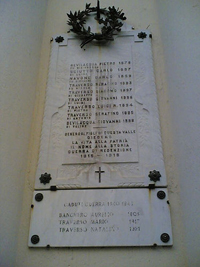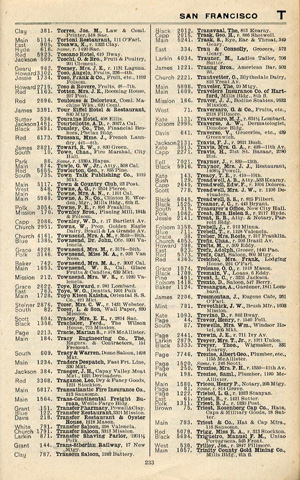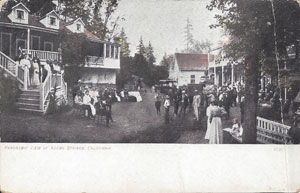Family
Vittorio Traverso & Luisa Bacigalupi
Mark Twain was working for the San Francisco Dramatic Chronicle at the same time Vittorio Traverso was born in Pentema in the municipality of Torriglia, in the province of Genova, region Liguria, Italy on March 15, 1866. Traverso is an Italian name meaning ‘transverse.’
Pentema is now an exceedingly small village of one hundred buildings perched upon a mountainside located near the Swiss border with the Mediterranean seacoast on one side and mountains on the other. Eighty-six of the buildings were built before 1919.
According to his certificate of death, Vittorio’s father's first name was Giacomo. (Giacomo's death in Italy, 1897 | See church and plaque to right.) Giacomo and his family were farmers growing grapes and raising a small tribe of goats. During Vittorio’s first 22 years, the Italian government continued to change leadership through battles with other countries and itself. The governments became more interested in politics, ignoring the difficulties the farmers were enduring. Life in this village was predictable and without many opportunities for 22-year-old Vittorio. Between the years of 1800 and 1890, more than 300,000 Northern Italians came to the United States where they became prominent as fruit merchants in New York and wine growers in California.
Vittorio migrated by himself from Italy to the United States. It is most likely that Vittorio traveled by train from Genoa to Port Le Harve, Normandy, France. The passenger data file from the ship La Champagne indicates that Vittorio arrived in New York on February 27, 1888. He booked transit through steerage with two others with the last name of Traverso: Gsidore and Andria. Their occupation listings were as farmers. The families were in Bow Compartment B. The voyage probably took about eight days in very cramped quarters. About 75% of immigrants entering the United States between August 3, 1855, and December 31, 1889, passed through Castle Garden Depot located near the tip of Manhattan. Today, about 20% of Americans can trace their ancestry to someone who came through Castle Garden. If Vittorio rode by train from New York to San Francisco, the trip would have taken between seven to eight days.

Click on photo to get facts about Pentema.
Luisa Bacigalupi was born on July 26, 1875, in Carasco, Liguria, Italy. She immigrated in 1890 by herself from Italy to live with a brother on Gerke Alley in San Francisco. Carasco is a municipality in the Metropolitan City of Genoa in the Italian region Liguria, located about 35 kilometers (about 23 miles) east of Genoa in the Fontanabuona Valley. Bacigalupi is an Italian plural form of Bacigalupo. This Italian name of uncertain origin is from bacigare ‘to kiss’ and lupo ‘wolf.’

Click on photo to get facts about Carasco.
There is evidence that Luisa’s family was living on Gerke Alley opening onto Dupont Street and a block down from Greenwich Street. According to the Langley Directory for 1895, Victor [sic] Traverso was living at 5 Gerke Alley and working as a laborer. David F. Myrick’s book, San Francisco’s Telegraph Hill, includes a story of Frank Bacigalupi purchasing a property at 6 Gerke Alley built in 1884. Myrick adds that there “was a restaurant and a rooming house at the northeast corner of Grant Avenue (Dupont) and Gerke.”9 The Telegraph Hill Hotel at 491 Greenwich Street was located at the southeast corner, the same side of Dupont Street as Gerke Alley. The 1880 U.S. Census indicates the Frank Shelton family lived at 4 Gerke Alley. Frank helped establish the first colored Baptist church at 1654 Dupont Street. The 1895 Langley Directory indicated that a Frank Shelton was living at 2 1/2 Gerke Alley. Frank’s daughter Julia Ann married Captain William T. Shorey in 1887. William was a late 19th-century African American whaling ship captain known to his crew as the Black Ahab. He died in Oakland, CA.
TraversoName Meaning Italian: nickname from traverso ‘transverse’ in any of several transferred senses: ‘thick-set’, ‘broad-shouldered’; less commonly ‘cross-eyed’, ‘squinting’, or ‘hostile’, ‘perverse’.
BacigalupiName Meaning Italian: patronymic or plural form of Bacigalupo. Southern Italian: of uncertain origin; perhaps from bacigare (an unattested verb related to baciare ‘to kiss’) + lupo ‘wolf’.
Read more about the "Great Arrival" of Italians to America.

Traverso Archives
Vittorio met Luisa and four years later, 1 April 1894, they were married. Vittorio was 6'3" tall and Luisa was 5' tall. A year later they had William (29 Mar 1895). Luisa may have been a seamstress and Vittorio was working in a grocery.
Vittorio found he could make better money as a miner at the Great Western Quicksilver Mine in Middletown, Lake County ($3 a day) so he moved his family there. (Read lower portion of note from B. T. Rocca.) Their second son, Victor, was born there (16 January 1898). Besides working in the mine, they grew vegetables and sold them to the resorts.
They saved their money and around the turn of the century (1900) they returned to San Francisco. On 9 February 1901, Vittorio purchased 491 Greenwich at Dupont for the sum of three thousand dollars. (First Deed)
John, their third son, was born 5 February 1902 in San Francisco. On 15 April of that year, Vittorio became a naturalized United States citizen. The record was lost during the Quake of 1906 and his naturalization was reestablished on 5 January 1909 in the San Francisco Superior Court by Judge Thomas Graham. This Voter Registration page includes Vittorio. Note his address is at 439 Greenwich.
Page 233 from the PACIFIC TELEPHONE AND TELEGRAPH CO. SAN FRANCISCO TELEPHONE DIRECTORY JUNE 1902. It lists Traverso V. Groceries at 439 Greenwich with DAVIS 641 as the phone number. The research is continuing to try to understand why Vittorio bought the grocery at 491 Greenwich, but Vic worked in a grocery at 439 Greenwich according to the San Francisco City Directories.

"For most of its 150-year history, Telegraph Hill was a working-class neighborhood, and it remained unapologetically so until the 1930s. Early photographs of the Hill show a neighborhood of trash-strewn steep dirt and gravel streets (often little more than paths) with goats grazing on the unbuilt portions. The streets were lined with small false-front or gable-roofed Italianate-style cottages, with the occasional multi-story balconied dwelling. These worker's homes were built on the Hill because steep grades kept land prices affordable and because the Hill was close to the piers and warehouses of the Northeastern waterfront where many of these workers had jobs. Rickety wooden stairs linked the top of the Hill with that waterfront. Longshoremen, in particular, had an advantage living on Telegraph Hill because they could keep an eye out for incoming ships, allowing them to make it to the 'shape-up' at the piers before the arrival of other would-be job-seekers."(Telegraph Hill, September 2002 by Christopher P. Verplanck)
Read More about Telegraph HillMore about Great Western Mine
Slide 20
"Between 1875 and 1900 the Great Western Quicksilver Mine Company, located on the border of Sonoma and Lake Counties, became the most important mercury producing mine in California. At its peak, the mine shipped between 27,000 and 31,500 tons of mercury per year to be used in gold mining operations. Located some 45 miles outside Calistoga, the mine transported the quicksilver by horse-drawn wagon over rough mountain roads, which sometimes took an entire week of rough travel to reach Calistoga. There, it was shipped by rail to San Francisco."
A Memorial and Biographical History of Northern California, page 148.
"Residence number 17 is the boarding house at the Great Western Mine, under the charge of Mary Driscoll, brought in from Shasta County for that role by mine superintendent Andrew Rocca, her husband, Timothy, her nephew Michael, who serves as waiter, and cook Charley Denver. Guests include Andrew Rocca, his new wife Mary Ruby; the teacher who replaced her, R. D. Reed; and eight mine workers." http://middletownhistory.weebly.com/middletown-1890.html
Click on GoogleBooks link to view in larger format.
April 18, 1906 was the day of the earthquake. The hotel was completely destroyed. So, Vittorio took his wife and three boys and moved them to a ranch in Pleasanton, which he had just leased to grow grapes to make wine for the hotel.
After the family was settled, he returned to San Francisco to rebuild his hotel. He financed the reconstruction by borrowing money from friends, without signed notes, and paid every single one back! When the hotel was rebuilt, he moved his family back into two rooms of the hotel. Vittorio was the bartender, goodwill and PR man; Luisa was cook for 22 boarders and sometimes fed as many as 250 at one seating. The three boys worked as waiters, busboys, and bartenders.
Youngest son, Jack, recalled polishing all the mirrors, brass cuspidors, and brass foot rests every Saturday for 50 cents!
In July, 1906, Vittorio was granted a liquor license from the City of San Francisco. There was a listing of those receiving licenses in the The San Francisco Call on Tuesday, July 31, 1906.

In 1908, the saloon on the corner was converted into a grocery store by Vittorio. (Second Deed in name of V. Traverso) The 1910 US Census includes 25 boarders. In early 1933, the hotel was remodeled into apartments and were owned by the Traverso's until sold in 1977.
Vittorio and Luisa retired and lived next door at 1654 Grant Avenue which Vittorio purchased November 17, 1909.
Vittorio became ill with pleurisy in 1925. He smoked 20 to 30 cigars a day. He died December 7, 1933. Luisa moved to an apartment at 487 Greenwich Street. She died December 20, 1937. Both Vittorio and Luisa were buried at Cypress Lawn Memorial Cemetery in Colma, just south of San Francisco.

Traverso Archives | Luisa 1936

Traverso Archives
1909 | Jack 7-years old | Bill 14-years old | Vic 10-years old
Some Postcards
Use F5 key to refresh this website.
2006-2025 © Rainbow Stores Web Site | A Historical Account of San Francisco's First Wholesale Grocery Co-op
Site Designed/Maintained by Papillon.site
Owner: Lou Thompson, Grand-daughter of John A. Traverso
Email Webmaster | lou@papillon.site
All rights reserved. No part of this website may be reproduced or otherwise used without the express written consent of the site owner.
















